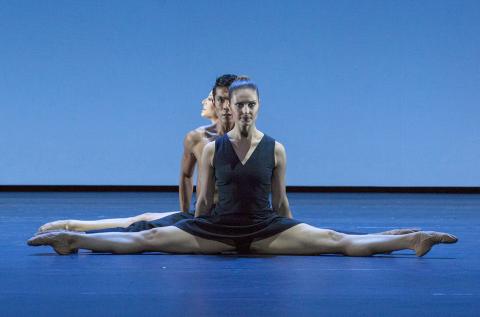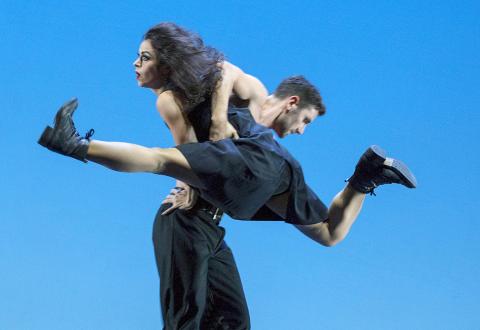There could have been no better program to launch the National Kaohsiung Center for the Arts’s (Weiwuying) portion of the Taiwan International Festival of Arts (TIFA) than the Ballett am Rhein Dusseldorf Duisburg with artistic director Martin Schlapfer’s 7.
Accompanied by the Taipei Symphony Orchestra (台北市立交響樂團) under the baton of Weiwuying artistic director Chien Wen-pin (簡文彬), the troupe gave a dynamic performance, matched by that of the orchestra, that fully merited the repeat curtain calls on Saturday last week.
Audiences in Taiwan have so little opportunity to see a full-length contemporary ballet that such performances can be counted on two hands: Ballet Preljocaj’s Snow White and La Fresque (The Painting on the Wall), Lin Mei-hong’s (林美虹) Schwanengesang (Swan Song) for Tanztheater des Staatstheaters Darmstadt and The Little Mermaid for TANZLIN.Z, the Hong Kong Ballet’s (香港芭蕾舞團) ALICE (in wonderland) or Allen Yu’s (余能盛) works such as Lost Illusion (失落的幻影) and his Tchaikovsky-based ballets. To see one that is completely abstract is rarer still.

Photo courtesy of Gert Weigelt
So there was a feeling of excitement surrounding the Ballett am Rhein’s arrival in Taiwan with Schlapfer’s 2013 ballet 7, set to Gustav Mahler’s Symphony No. 7 in E minor.
Schlapfer had avoided using Mahler’s works for years after being burned by criticism of his 1995 work for the Berner Ballett, Ruckert Songs. It was not until he took over the Ballet Am Rhein in 2009 that turned to the composer again.
It is a very good thing that he did.

Photo courtesy of Gert Weigelt
His 7 is a dramatic, powerful ballet that perfectly plays off Mahler’s sweeping score, thanks to Schlapfer’s musicality.
While there is no story line, the ballet appears to be about human relationships, but one that encompasses the entire gamut from the solitude of singletons, to couples, trios and small groups.
Dancers enter, interact and then depart, sometimes after a rejection, other times of their own volition.
Partners are often swapped, as are the power dynamics between male and female.
The 40-strong company was only on stage together at the end, in a finale that sees them run almost en masse around a circle of stools, a lone woman in the center. It was a fitting climax that matches Mahler’s score.
Florian Etti kept his palate for the set and costume design in shades of black, lightened occasionally with silver, white and a touch of blue. The only stage adornment is a set of large, slightly reflective panels on the sides and back of the stage that rise, lower or divide.
The dancers perform in bare feet, black shoes, sometimes boots and sometimes in pointe shoes for the women. Each option adds another dimension to the dancing.
In different hands, 7 could have been a dark, dispiriting work. With Schlapfer and Chien, it is a visual and aural delight.
It is a rare ballet where men and women are given equally strong roles. The company’s dancers appear to be perfectly matched physically, in technique and articulated lines.
Schlapfer appears to have given almost every dancer a chance for a star turn in 7, be it a solo, in a couple or as part of a group, although it is difficult to be sure without a score card.
That display of equalitarianism is a reflection of how Schlapfer runs the multinational Ballett am Rhein: All the dancers are soloists; there are no principals, no corps de ballet.
However, some dancers did stand out: Sonny Locsin, Chidozie Nzerem, Daniel Smith and Alexandre Simoes among the men, and Virginia Segarra Vidal, Ann-Kathrin Adam, Wun Sze Chan and Doris Becker among the women, to name but a few.
The Ballett am Rhein and the Taipei Symphony Orchestra are now in Taichung, where they will give two performances at National Taichung Theater on Saturday and Sunday afternoons.
Dance fans should run, walk, take the bus, a train or the high-speed rail to Taichung this weekend — Ballett am Rhein’s 7 is a show not to missed.

The Directorate-General of Budget, Accounting and Statistics (DGBAS) told legislators last week that because the Chinese Nationalist Party (KMT) and Taiwan People’s Party (TPP) are continuing to block next year’s budget from passing, the nation could lose 1.5 percent of its GDP growth next year. According to the DGBAS report, officials presented to the legislature, the 2026 budget proposal includes NT$299.2 billion in funding for new projects and funding increases for various government functions. This funding only becomes available when the legislature approves it. The DGBAS estimates that every NT$10 billion in government money not spent shaves 0.05 percent off

Dec. 29 to Jan. 4 Like the Taoist Baode Temple (保德宮) featured in last week’s column, there’s little at first glance to suggest that Taipei’s Independence Presbyterian Church in Xinbeitou (自立長老會新北投教會) has Indigenous roots. One hint is a small sign on the facade reading “Ketagalan Presbyterian Mission Association” — Ketagalan being an collective term for the Pingpu (plains Indigenous) groups who once inhabited much of northern Taiwan. Inside, a display on the back wall introduces the congregation’s founder Pan Shui-tu (潘水土), a member of the Pingpu settlement of Kipatauw, and provides information about the Ketagalan and their early involvement with Christianity. Most

The People’s Republic of China (PRC) was out in force in the Taiwan Strait this week, threatening Taiwan with live-fire exercises, aircraft incursions and tedious claims to ownership. The reaction to the PRC’s blockade and decapitation strike exercises offer numerous lessons, if only we are willing to be taught. Reading the commentary on PRC behavior is like reading Bible interpretation across a range of Christian denominations: the text is recast to mean what the interpreter wants it to mean. Many PRC believers contended that the drills, obviously scheduled in advance, were aimed at the recent arms offer to Taiwan by the

It is a soulful folk song, filled with feeling and history: A love-stricken young man tells God about his hopes and dreams of happiness. Generations of Uighurs, the Turkic ethnic minority in China’s Xinjiang region, have played it at parties and weddings. But today, if they download it, play it or share it online, they risk ending up in prison. Besh pede, a popular Uighur folk ballad, is among dozens of Uighur-language songs that have been deemed “problematic” by Xinjiang authorities, according to a recording of a meeting held by police and other local officials in the historic city of Kashgar in